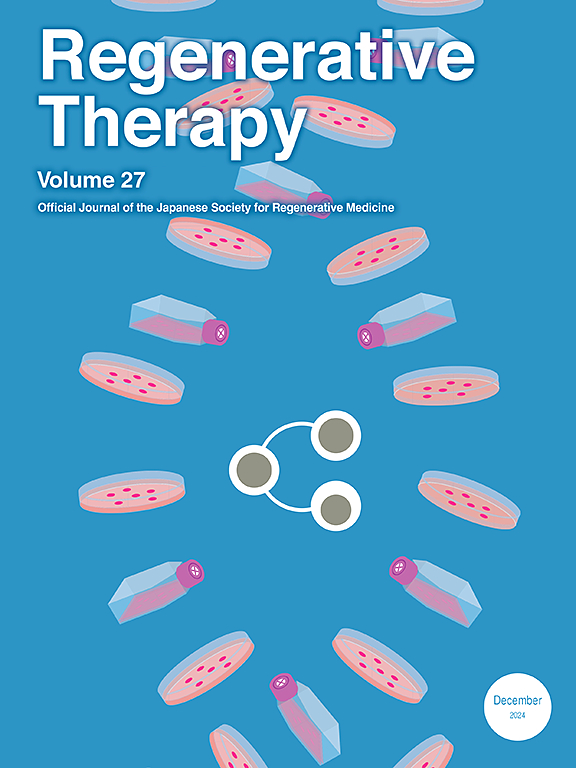由自体真皮成纤维细胞组成的生物人工胸膜用于术中胸膜损伤引起的肺气漏的中期结果:1例报告
IF 3.5
3区 环境科学与生态学
Q3 CELL & TISSUE ENGINEERING
引用次数: 0
摘要
内脏胸膜是一层薄的浆膜,紧密地覆盖在肺表面。胸膜受伤或破裂,导致空气在胸腔中积聚,肺部塌陷。由于肺部漏气(LALs)引起的胸膜压力增加会产生严重的影响。肺切除术引起的胸膜损伤是LALs的常见原因。术后LALs延长了患者住院时间,对患者术后生活质量有显著影响。基于上述背景,我们首次在临床研究中开发并报道了真皮成纤维细胞片(真皮成纤维细胞片,真皮成纤维细胞片)作为生物人工胸膜用于闭合人类术中胸膜损伤引起的LALs的有效性。目前还没有利用组织工程技术制造生物人工胸膜的中期报道。在本研究中,我们报告了用培养的自体DFS生物人工胸膜移植治疗两例胸膜损伤的安全性。2016年5月至2018年3月期间,5例符合标准并使用生物人工胸膜闭合LAL的患者中有2例进行了中期随访。虽然标准包括LAL关闭后6个月的监测期,但这两名患者在监测期后继续来我院治疗其他合并症。案例1。男性,40多岁,因Takayasu病接受长期类固醇治疗,因左前内侧基底段良性肺肿瘤行胸腔镜肺楔形切除术。手术中,使用自动吻合器将切除边缘的小LALs用生物人工胸膜闭合,具体来说,总共有3个dfs。在患者51个月的随访中,未见LAL复发、肿瘤发展、浸润和纤维形成。例2。一位70多岁的女性患者有大泡合并肺纤维化和肺气肿(CPFE)。胸腔镜下行左下叶大泡切除术,术中用共8个dfs组成的生物人工胸膜封闭主要LALs。术后2个月因对侧肺炎再次入院。随访82个月,术后左肺未见LAL复发及肿瘤发展。然而,胸部CT显示进展缓慢的CPFE病变。结论2例胸膜损伤采用培养的自体DFS进行生物人工胸膜移植具有中期安全性。本文章由计算机程序翻译,如有差异,请以英文原文为准。
Mid-term outcomes of a bio-artificial pleura composed of autologous dermal fibroblasts used to close intraoperative pulmonary air leaks caused by intraoperative pleural injury: A case report
Introduction
The visceral pleura is a thin, serous membrane that closely covers the surface of the lung. The pleura is injured or ruptured, causing air to accumulate in the thoracic cavity and the lung to collapse. Increased pleural pressure due to lung air leaks (LALs) from the lung can have serious effects. LALs are frequently observed due to pleural injury caused by lung resection. Postoperative LALs prolongs hospital stay and has a significant impact on patients' postoperative quality of life. Based on the above background, we developed and reported the effectiveness of dermal fibroblast sheet (DFS) as a bio-artificial pleura for closing LALs caused by intraoperative pleural injury in humans for the first time in a clinical study. There are no mid-term reports of bio-artificial pleura created using tissue engineering. In this study, we report the safety of bio-artificial pleural transplantation using cultured autologous DFS for pleural injury in two cases.
Previous study and case presentation
Two of the five patients who met the criteria and underwent LAL closure using a bio-artificial pleura between May 2016 and March 2018 were followed up mid-term. Although the criteria included a 6-month monitoring period after LAL closure, these two patients continued to visit our hospital beyond the monitoring period for treatment of other comorbid conditions. Case 1. A male in his 40s who was receiving long-term steroid therapy for Takayasu's disease and underwent thoracoscopic lung wedge resection for a benign lung tumor in the left anteromedial basal segment. During surgery, the minor LALs from the resection margins with an automatic stapler were closed with a bio-artificial pleura, specifically, a total of three DFSs. During the patient's 51-month follow-up, no LAL recurrence, tumor development, infiltration, and fibrogenesis were observed. Case 2. A female patient in her 70s had bullae associated with combined pulmonary fibrosis and emphysema (CPFE). Thoracoscopic bullectomy of the left lower lobe was performed, and the major LALs were closed intraoperatively with a bio-artificial pleura consisting of a total of eight DFSs. She was readmitted for contralateral pneumonia 2 months after surgery. During a follow-up period of 82 months, no LAL recurrence and tumor development was observed in the operated left lung. However, chest CT revealed slowly progressing CPFE lesions.
Conclusions
This report of two cases demonstrated the mid-term safety of bio-artificial pleural transplantation using cultured autologous DFS for pleural injury.
求助全文
通过发布文献求助,成功后即可免费获取论文全文。
去求助
来源期刊

Regenerative Therapy
Engineering-Biomedical Engineering
CiteScore
6.00
自引率
2.30%
发文量
106
审稿时长
49 days
期刊介绍:
Regenerative Therapy is the official peer-reviewed online journal of the Japanese Society for Regenerative Medicine.
Regenerative Therapy is a multidisciplinary journal that publishes original articles and reviews of basic research, clinical translation, industrial development, and regulatory issues focusing on stem cell biology, tissue engineering, and regenerative medicine.
 求助内容:
求助内容: 应助结果提醒方式:
应助结果提醒方式:


